The Effect of Hydroxy Silicone Oil Emulsion on the Waterproof Performance of Cement
Abstract
:1. Introduction
2. Materials and Methods
2.1. Materials
2.2. Synthesis of Hydroxyl-Terminated Silicone Oil Emulsifier
2.3. Preparation of Hydroxyl-Terminated Silicone Oil Emulsion
2.4. Preparation of Cement Slurry
2.5. Preparation of Cement Mortar
2.6. Measurement and Characterization
2.6.1. Measurement of Hydrophobic Modifier’s Physicochemical Properties
Cloud Point, HLB Value, Self-Emulsification Capability, and PH Measurement
Viscosity and Particle Size Measurement
2.6.2. Characterization of Hydrophobic Modifier Structure
2.6.3. Characterization of Cement Mortar Structure
2.6.4. Testing of Cement Mortar Workability and Mechanical Properties
Standard Consistency and Setting Time Testing of Cement Mortar
Flowability Testing of Cement Mortar
Compressive Strength Testing of Cement Mortar
2.6.5. Evaluation of Hydrophobic Properties of Cement Mortar
Water Contact Angle Measurement
Water Absorption Testing
2.6.6. Pore Structure Analysis of Cement Mortar
3. Results and Discussion
3.1. Analysis of Synthesis of Hydroxyl-Terminated Silicone Oil Emulsifiers
3.2. Structure Analysis of Hydroxy-Terminated Silicone Oil Emulsifier
3.3. Preparation and Performance Analysis of Hydroxy-Terminated Silicone Oil Emulsion
3.4. Influence of Hydroxy-Terminated Silicone Oil Emulsion on the Structure of Cement Mortar
3.5. Hydroxy Silicone Oil Emulsion Dispersion Properties of Cement Mortar and Performance Analysis of Net Cement Slurry Setting Time
3.5.1. Dispersion
3.5.2. Influence on Setting Time of Clean Pulp
3.6. Analysis of Hydroxy Silicone Oil Emulsion on the Properties of Cement Mortar
3.6.1. Effects on Cement Mortar Water Contact Angle
3.6.2. Influence on Water Absorption of Cement Mortar
3.6.3. Influence on Folding Strength and Compressive Strength of Cement Mortar
3.6.4. Influence on the Pore Structure of Cement Mortar
4. Conclusions
- Polyether-modified silicone oil with an HLB value of 8.2 and turbidity point of 45 °C was prepared by using a vinyl polyoxyethylene ether and silicon hydrogen bond molar ratio of 1.0:1.2, which has excellent self-emulsifying properties and is a stable light blue micelle with a particle size of 63 nm. Then, five kinds of hydroxy-terminated silicone oil emulsions were prepared by using it with OP-7, but with the increase in OP-7, the stability of the hydroxy-terminated silicone oil emulsions gradually deteriorated.
- HSOE has a good hydrophobic effect, which can significantly improve the contact angle of cement mortar, in line with expectations, and the smaller the particle size of emulsion and the more uniform the dispersion of hydrophobic substances, the better the hydrophobic effect.
- PMSO has a significant delay effect on the early stage of cement hydration, but it does not prevent the later stage of cement hydration, and with the extension of time, the loss of compressive strength gradually decreases compared with the blank group.
- In the future, an emulsifier that can emulsify hydroxyl silicone oil and has no effect on cement hydration can be selected. The influence of the emulsifier on the stability of water-based emulsion can be further discussed, and a long-term durability experiment could be carried out to study the influence of emulsion on shrinkage and long-term stability.
Author Contributions
Funding
Data Availability Statement
Acknowledgments
Conflicts of Interest
References
- Zhou, M.; Lu, W.; Song, J.; Lee, G.C. Application of Ultra-High Performance Concrete in Bridge Engineering. Constr. Build. Mater. 2018, 186, 1256–1267. [Google Scholar] [CrossRef]
- Liu, P.; Feng, C.; Wang, F.; Gao, Y.; Yang, J.; Zhang, W.; Yang, L. Hydrophobic and Water-Resisting Behavior of Portland Cement Incorporated by Oleic Acid Modified Fly Ash. Mater. Struct. 2018, 51, 38. [Google Scholar] [CrossRef]
- Fanijo, E.O.; Kolawole, J.T.; Almakrab, A. Alkali-Silica Reaction (ASR) in Concrete Structures: Mechanisms, Effects and Evaluation Test Methods Adopted in the United States. Case Stud. Constr. Mater. 2021, 15, e00563. [Google Scholar] [CrossRef]
- Zhao, J.; Tong, L.; Li, B.; Chen, T.; Wang, C.; Yang, G.; Zheng, Y. Eco-Friendly Geopolymer Materials: A Review of Performance Improvement, Potential Application and Sustainability Assessment. J. Clean. Prod. 2021, 307, 127085. [Google Scholar] [CrossRef]
- Sun, D.; Wu, K.; Shi, H.; Zhang, L.; Zhang, L. Effect of Interfacial Transition Zone on the Transport of Sulfate Ions in Concrete. Constr. Build. Mater. 2018, 192, 28–37. [Google Scholar] [CrossRef]
- Zhang, J.; Zhou, X.; Zhang, Y.; Wang, M.; Zhang, Y. Stable Process of Concrete Chloride Diffusivity and Corresponding Influencing Factors Analysis. Constr. Build. Mater. 2020, 261, 119994. [Google Scholar] [CrossRef]
- Zhao, J.; Gao, X.; Chen, S.; Lin, H.; Li, Z.; Lin, X. Hydrophobic or Superhydrophobic Modification of Cement-Based Materials: A Systematic Review. Compos. Part B Eng. 2022, 243, 110104. [Google Scholar] [CrossRef]
- Muzenski, S.; Flores-Vivian, I.; Sobolev, K. Hydrophobic Engineered Cementitious Composites for Highway Applications. Cem. Concr. Compos. 2015, 57, 68–74. [Google Scholar] [CrossRef]
- Yao, H.; Xie, Z.; Huang, C.; Yuan, Q.; Yu, Z. Recent Progress of Hydrophobic Cement-Based Materials: Preparation, Characterization and Properties. Constr. Build. Mater. 2021, 299, 124255. [Google Scholar] [CrossRef]
- Flores-Vivian, I.; Hejazi, V.; Kozhukhova, M.I.; Nosonovsky, M.; Sobolev, K. Self-Assembling Particle-Siloxane Coatings for Superhydrophobic Concrete. ACS Appl. Mater. Interfaces 2013, 5, 13284–13294. [Google Scholar] [CrossRef] [PubMed]
- Ray, S.S.; Peddinti, P.R.T.; Soni, R.; Kim, B.; Park, Y.-I.; Kim, I.-C.; Lee, C.Y.; Kwon, Y.-N. Effectiveness of Nanoparticles-Based Ultrahydrophobic Coating for Concrete Materials. J. Build. Eng. 2023, 66, 105799. [Google Scholar] [CrossRef]
- Li, G.; Yue, J.; Guo, C.; Ji, Y. Influences of Modified Nanoparticles on Hydrophobicity of Concrete with Organic Film Coating. Constr. Build. Mater. 2018, 169, 1–7. [Google Scholar] [CrossRef]
- Almusallam, A.A.; Khan, F.M.; Dulaijan, S.U.; Al-Amoudi, O.S.B. Effectiveness of Surface Coatings in Improving Concrete Durability. Cem. Concr. Compos. 2003, 25, 473–481. [Google Scholar] [CrossRef]
- Szafraniec, M.; Barnat-Hunek, D.; Grzegorczyk-Frańczak, M.; Trochonowicz, M. Surface Modification of Lightweight Mortars by Nanopolymers to Improve Their Water-Repellency and Durability. Materials 2020, 13, 1350. [Google Scholar] [CrossRef]
- Szymańska, A.; Dutkiewicz, M.; Maciejewski, H.; Palacz, M. Simple and Effective Hydrophobic Impregnation of Concrete with Functionalized Polybutadienes. Constr. Build. Mater. 2022, 315, 125624. [Google Scholar] [CrossRef]
- Jiang, L.; Zheng, H.; Xiong, J.; Fan, Z.; Shen, T.; Xie, H.; Chen, M.; Li, J.; Gu, Z.; Li, H.; et al. Fabrication of Negative Carbon Superhydrophobic Self-Cleaning Concrete Coating: High Added-Value Utilization of Recycled Powders. Cem. Concr. Compos. 2023, 136, 104882. [Google Scholar] [CrossRef]
- Xue, X.; Li, Y.; Yang, Z.; He, Z.; Dai, J.-G.; Xu, L.; Zhang, W. A Systematic Investigation of the Waterproofing Performance and Chloride Resistance of a Self-Developed Waterborne Silane-Based Hydrophobic Agent for Mortar and Concrete. Constr. Build. Mater. 2017, 155, 939–946. [Google Scholar] [CrossRef]
- Shahbazi, R.; Habibnejad Korayem, A.; Bazli, M. Dispersion of Hydrophobic Waste Amorphous Carbon Powder in Cementitious Environment and Its Effect on the Permeability of Cement Paste. Constr. Build. Mater. 2023, 400, 132888. [Google Scholar] [CrossRef]
- Chen, R.; Liu, J.; Mu, S. Chloride Ion Penetration Resistance and Microstructural Modification of Concrete with the Addition of Calcium Stearate. Constr. Build. Mater. 2022, 321, 126188. [Google Scholar] [CrossRef]
- Falchi, L.; Zendri, E.; Müller, U.; Fontana, P. The Influence of Water-Repellent Admixtures on the Behaviour and the Effectiveness of Portland Limestone Cement Mortars. Cem. Concr. Compos. 2015, 59, 107–118. [Google Scholar] [CrossRef]
- Zhu, Y.-G.; Kou, S.-C.; Poon, C.-S.; Dai, J.-G.; Li, Q.-Y. Influence of Silane-Based Water Repellent on the Durability Properties of Recycled Aggregate Concrete. Cem. Concr. Compos. 2013, 35, 32–38. [Google Scholar] [CrossRef]
- Mora, E.; González, G.; Romero, P.; Castellón, E. Control of Water Absorption in Concrete Materials by Modification with Hybrid Hydrophobic Silica Particles. Constr. Build. Mater. 2019, 221, 210–218. [Google Scholar] [CrossRef]
- Wang, F.; Lei, S.; Ou, J.; Li, W. Effect of PDMS on the Waterproofing Performance and Corrosion Resistance of Cement Mortar. Appl. Surf. Sci. 2020, 507, 145016. [Google Scholar] [CrossRef]
- Wu, S.; Zhang, C.; Zhou, F.; Ma, S.; Zheng, H. The Effect of Nano-Scale Calcium Stearate Emulsion on the Integral Waterproof Performance and Chloride Resistance of Cement Mortar. Constr. Build. Mater. 2022, 317, 125903. [Google Scholar] [CrossRef]
- ISO 679-2009; Cement—Test Methods—Determination of Strength. ISO: Geneva, Switzerland, 2009.
- ASTM C33; Standard Specification for Concrete Aggregates. ASTM: West Conshohocken, PA, USA, 2023.
- El-Nahhal, I.M.; El-Ashgar, N.M. A Review on Polysiloxane-Immobilized Ligand Systems: Synthesis, Characterization and Applications. J. Organomet. Chem. 2007, 692, 2861–2886. [Google Scholar] [CrossRef]
- Xu, J.Y.; Han, S.S. The Polyetherification Modified Reaction on Silicone Oil. AMR 2012, 560, 667–671. [Google Scholar] [CrossRef]
- ISO 1065:1991; Non-Ionic Surface-Active Agents Obtained from Ethylene Oxide and Mixed Non-Ionic Surface-Active Agents—Determination of Cloud Point. ISO: Geneva, Switzerland, 1991.
- ISO 23496:2019; Determination of pH Value—Reference BUFFER Solutions for the Calibration of pH Measuring Equipment. ISO: Geneva, Switzerland, 2019.
- ISO 9597:2008; Cement—Test Methods—Determination of Setting Time and Soundness. ISO: Geneva, Switzerland, 2008.
- GB/T 8077-2023; Methods for Testing Uniformity of Concrete Admixtures. Standardization Administration of China: Beijing, China, 2023.
- GB/T 2419-2005; Test Method for Fluidity of Cement Mortar. National Cement Standardization Technical Committee: Beijing, China, 2005.
- JC474-2008; Water-Repellent Admixture for Mortar and Concrete. Standardization Administration of China: Beijing, China, 2008.
- Li, W.; Zhu, X.; Hong, J.; She, W.; Wang, P.; Zuo, W. Effect of Anionic Emulsifier on Cement Hydration and Its Interaction Mechanism. Constr. Build. Mater. 2015, 93, 1003–1011. [Google Scholar] [CrossRef]
- Tan, Y.; Ouyang, J.; Lv, J.; Li, Y. Effect of Emulsifier on Cement Hydration in Cement Asphalt Mortar. Constr. Build. Mater. 2013, 47, 159–164. [Google Scholar] [CrossRef]
- Zhang, P.; Hou, Y.; Niu, K.; Tian, B.; Wang, H. Effects of Anionic Emulsifiers and Emulsified Asphalt on Hydration and Microstructure of Cement. Materials 2023, 17, 36. [Google Scholar] [CrossRef] [PubMed]
- Huang, Y.; Sarkar, D.K.; Grant Chen, X. Superhydrophobic Aluminum Alloy Surfaces Prepared by Chemical Etching Process and Their Corrosion Resistance Properties. Appl. Surf. Sci. 2015, 356, 1012–1024. [Google Scholar] [CrossRef]
- Zheng, J.; Cai, Y.; Hu, Y.; Zhu, J.; Wei, J.; Ma, Y.; Wan, J.; Fan, H. Bio-Based Epoxy Functionalized MQ Silicone Resins: From Synthesis to Toughened Epoxy Composites with Good Mechanical Properties, Thermal Resistance and Transparency. Polym. Chem. 2022, 13, 5325–5336. [Google Scholar] [CrossRef]
- Wang, F.; Zhang, M.; Lei, S.; Ou, J.; Li, W. Rapid Preparation of Superhydrophobic Surface on Cement Stone. Appl. Phys. A 2019, 125, 386. [Google Scholar] [CrossRef]
- She, Y.; Chen, Y.; Li, L.; Xue, L.; Yu, Q. Understanding the Generation and Evolution of Hydrophobicity of Silane Modified Fly Ash/Slag Based Geopolymers. Cem. Concr. Compos. 2023, 142, 105206. [Google Scholar] [CrossRef]
- Li, F. Investigation on Waterproof Mechanism and Micro-Structure of Cement Mortar Incorporated with Silicane. Constr. Build. Mater. 2020, 239, 117865. [Google Scholar] [CrossRef]

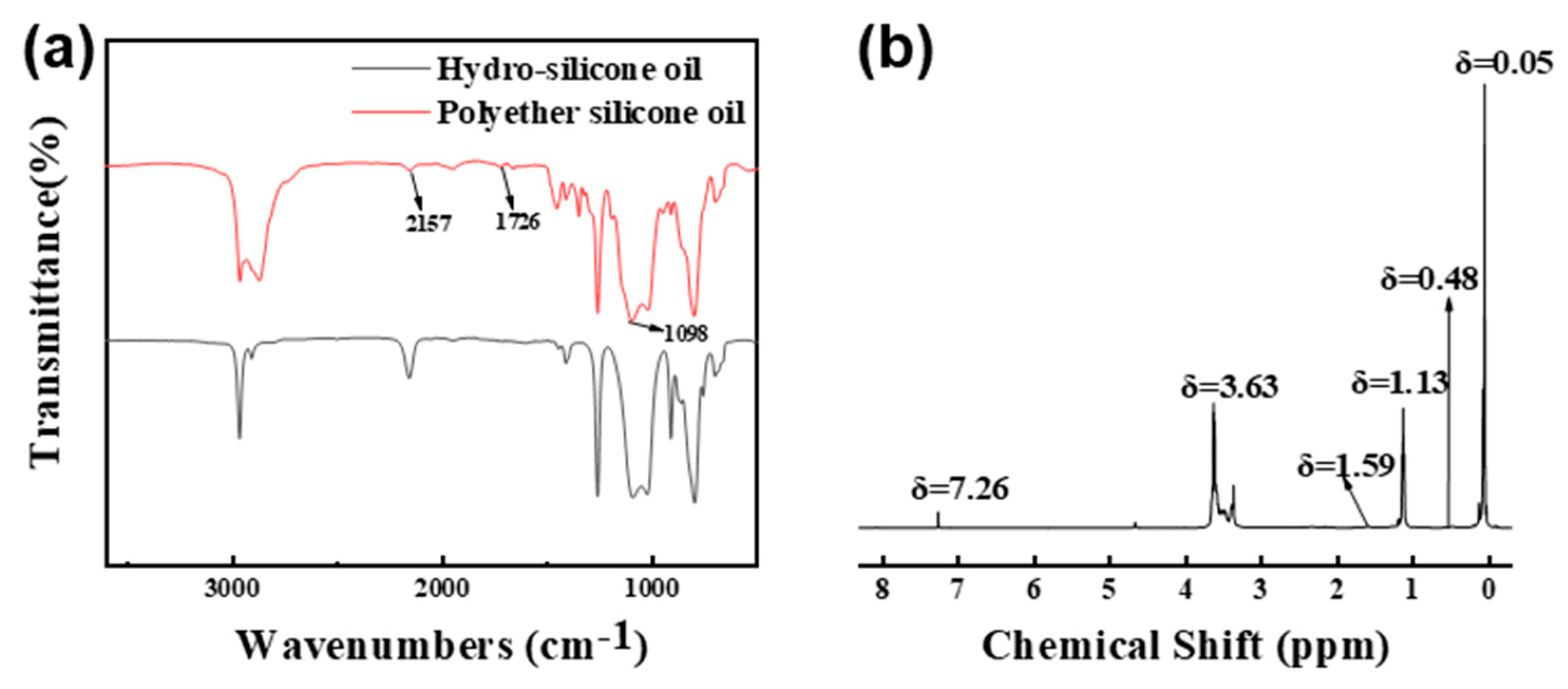



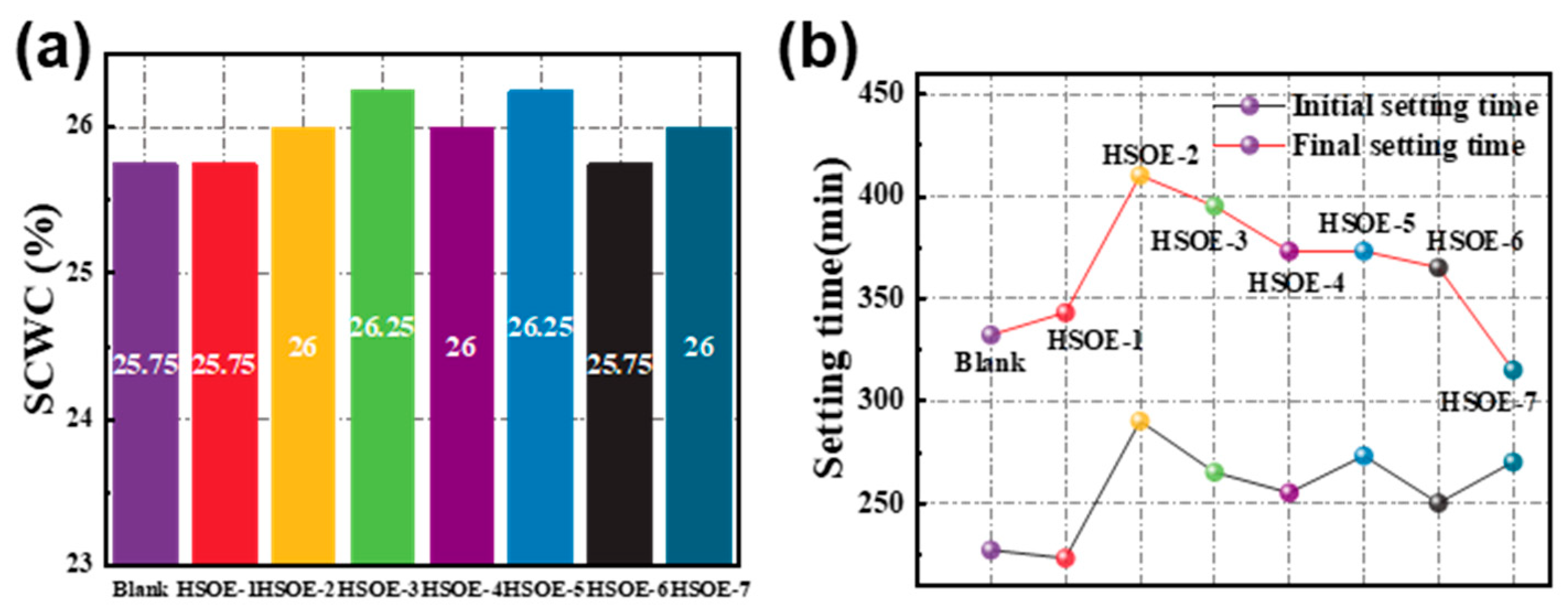
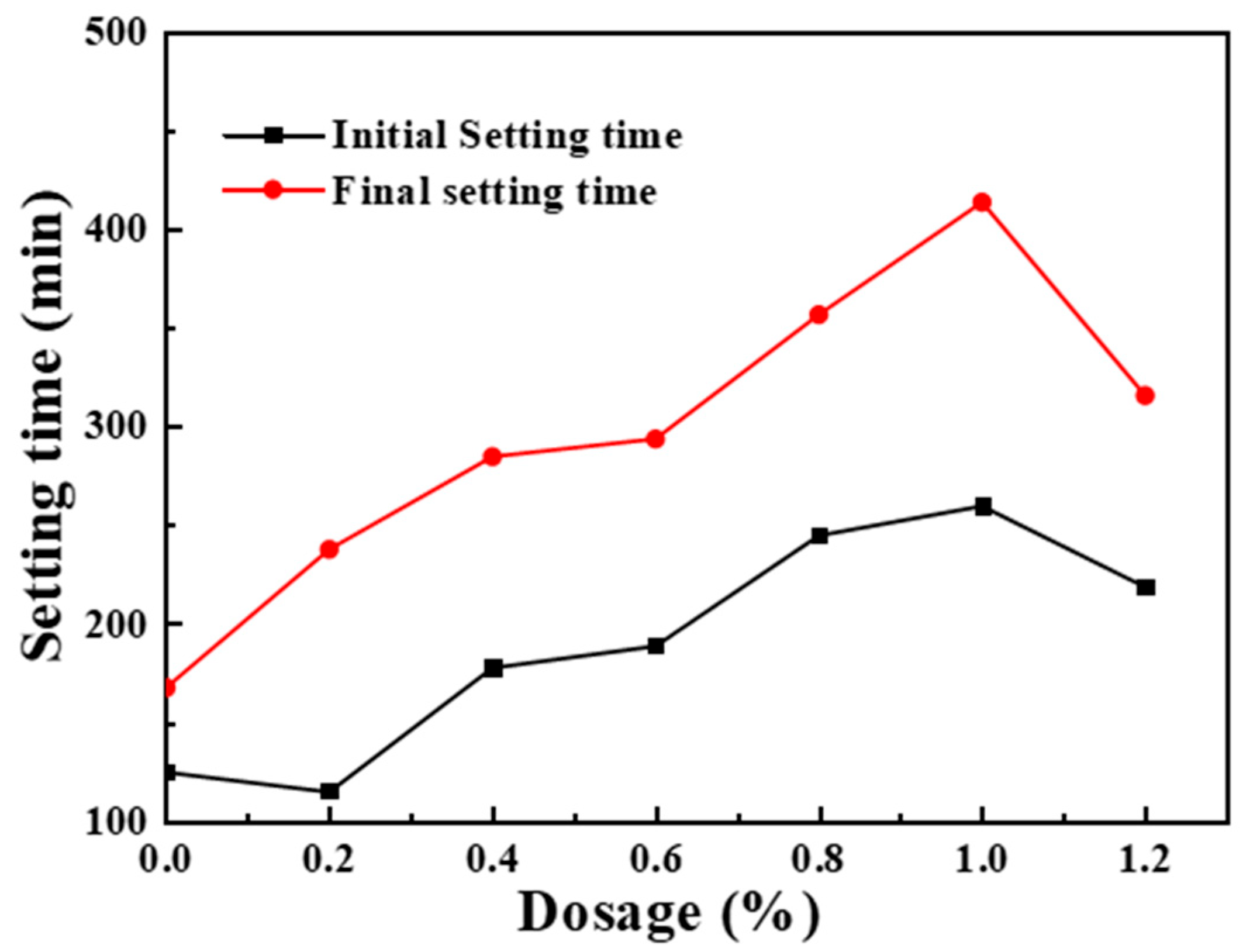
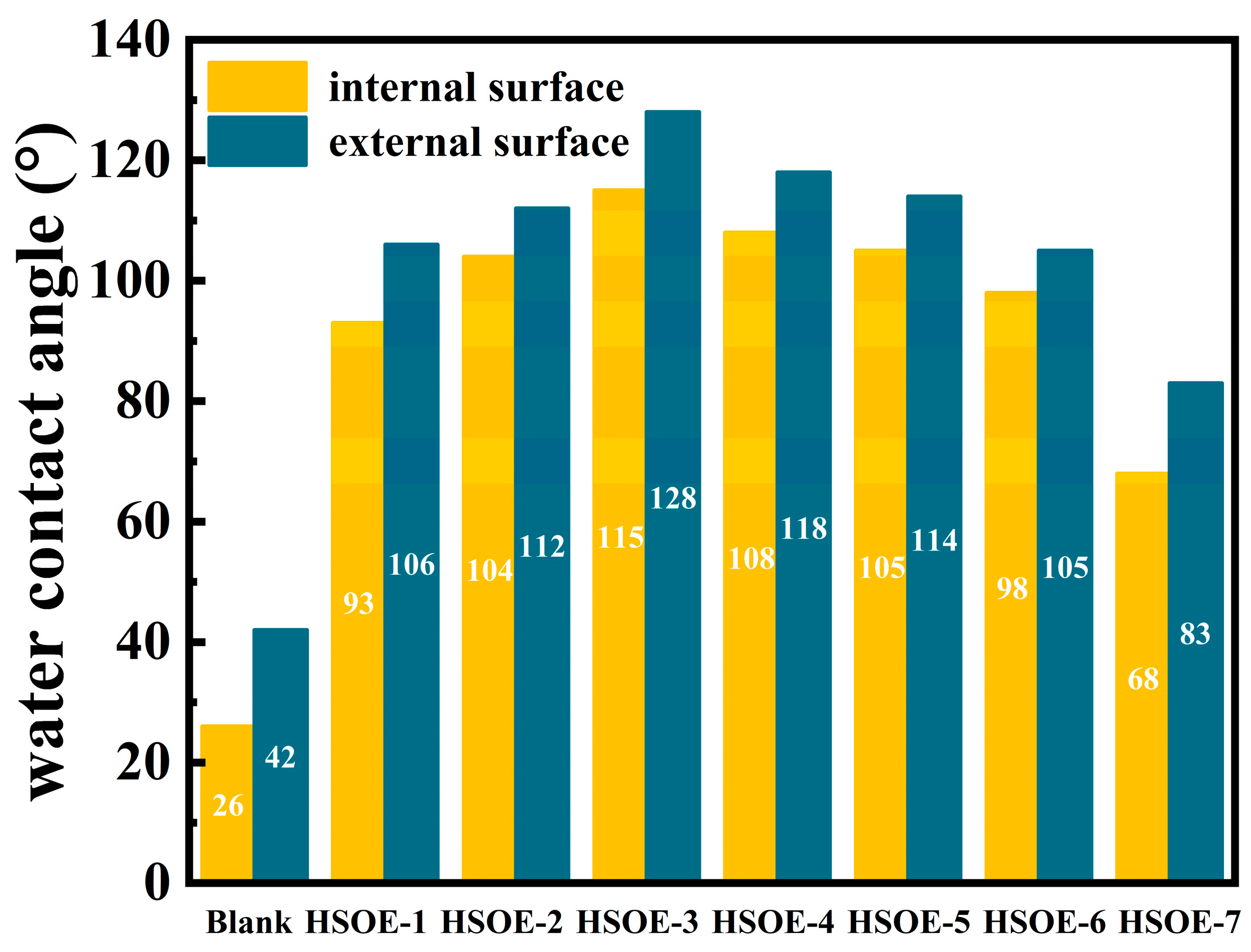
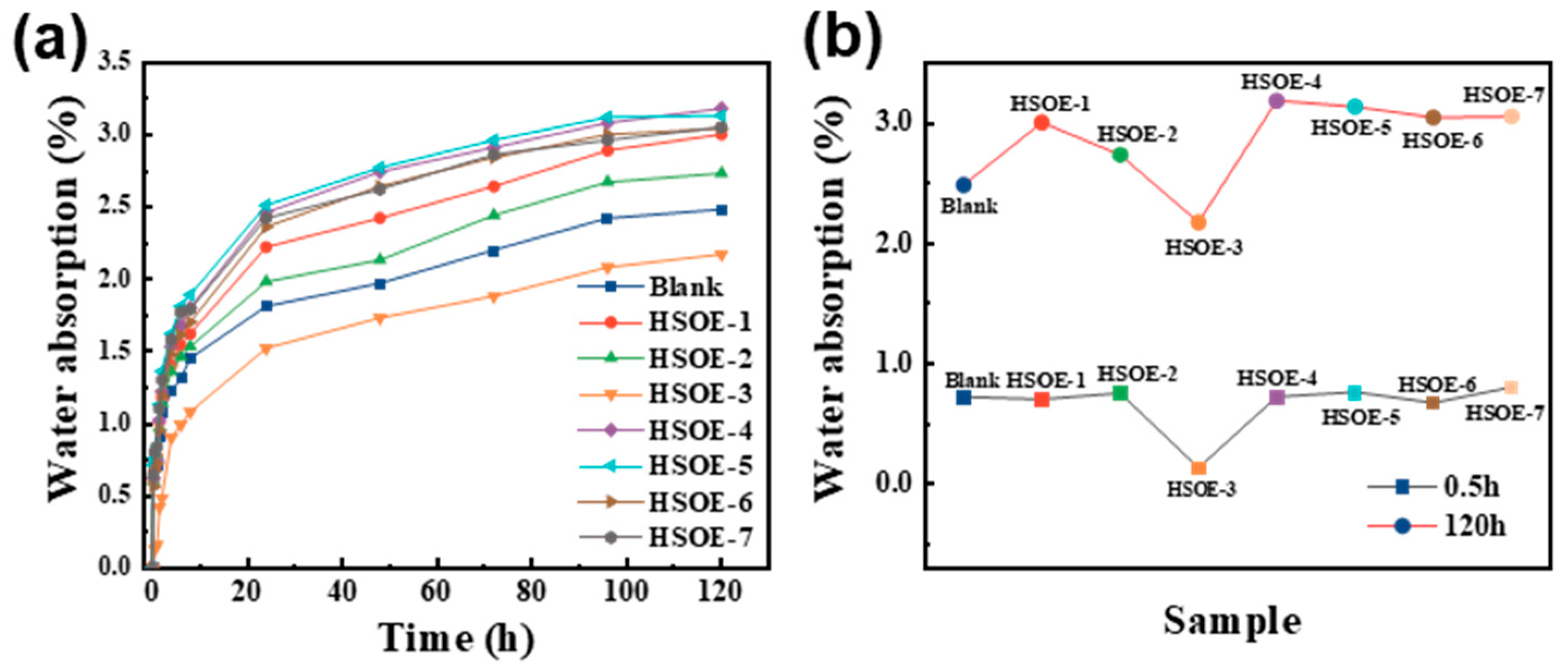
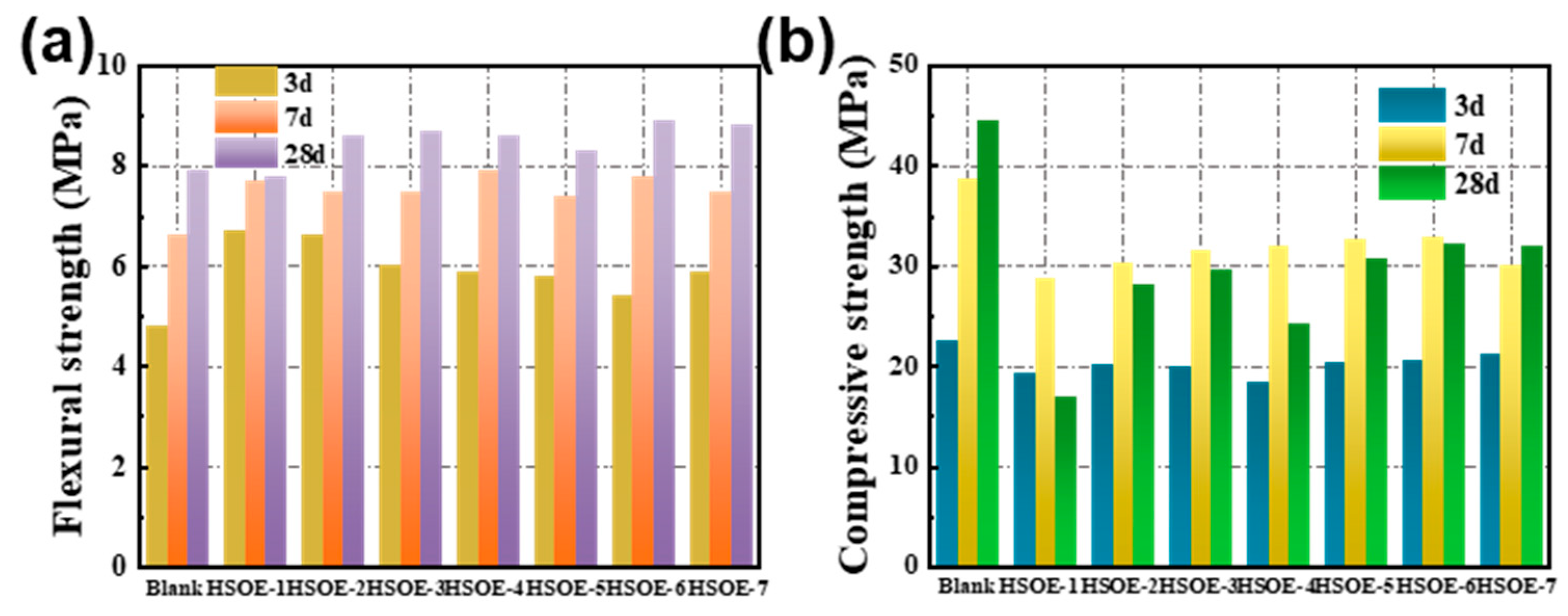


| Samples | Raw Material Ratio | Product Property | |||||
|---|---|---|---|---|---|---|---|
| n(C=C): n(Si-H) | HLB | Cloud Point (°C) | pH | Viscosity (mpa·s) | Micellar Morphology | Micelle Size (nm) | |
| PMSO-1 | 1.5:1.0 | 11.2 | 51 | 6.8 | 2100 | Reflex Blue | 53 |
| PMSO-2 | 1.0:1.0 | 9.4 | 48.5 | 7.2 | 2300 | Reflex Blue | 61 |
| PMSO-3 | 1.0:1.2 | 8.2 | 45 | 7.3 | 2600 | Reflex Blue | 63 |
| PMSO-4 | 1.0:1.4 | 7.5 | 41.5 | 7.3 | 2800 | Reflex Blue | 65 |
| PMSO-5 | 1.0:2.0 | 6.3 | 36 | 7.5 | 3000 | Light white | 93 |
| Sample | Emulsifier Species | Emulsifier Content | Hydroxy-Terminated Silicone Oil Concentration (%) | Emulsion Viscosity (mPa·s) | Emulsion Particle Size (nm) | Emulsion Stability |
|---|---|---|---|---|---|---|
| HSOE-1 | PMSO-3 | 10% | 40 | 45 | 1064 | Stabilization |
| HSOE-2 | PMSO-3 | 20% | 40 | 48 | 965 | Stabilization |
| HSOE-3 | PMSO-3 | 30% | 40 | 64 | 872 | Stabilization |
| HSOE-4 | PMSO-3:OP-7 = 3.5:0.5 | 10% | 40 | 50 | 1130 | Stabilization |
| HSOE-5 | PMSO-3:OP-7 = 3.0:1.0 | 10% | 40 | 54 | 1651 | Stabilization |
| HSOE-6 | PMSO-3:OP-7 = 2.0:2.0 | 10% | 40 | 56 | 2601 | Precipitation after 85 days |
| HSOE-7 | OP-7 | 10% | 40 | 65 | 3800 | Precipitation after 75 days |
| Element | UCM | MCM |
|---|---|---|
| C | 35.98 | 27.88 |
| O | 42.8 | 45.86 |
| Ca | 14.69 | 21.48 |
| Si | 6.53 | 4.78 |
| Sample | 28 Days of Compressive Strength (MPa) | 140 Days of Compressive Strength (MPa) |
|---|---|---|
| Blank | 44.6 | 47.8 |
| HSOE-1 | 16.9 | 20.7 |
| HSOE-2 | 28.2 | 30.6 |
| HSOE-3 | 29.7 | 32 |
| HSOE-4 | 24.2 | 27.3 |
| HSOE-5 | 30.7 | 32.4 |
| HSOE-6 | 32.3 | 34.9 |
| HSOE-7 | 32 | 38.6 |
Disclaimer/Publisher’s Note: The statements, opinions and data contained in all publications are solely those of the individual author(s) and contributor(s) and not of MDPI and/or the editor(s). MDPI and/or the editor(s) disclaim responsibility for any injury to people or property resulting from any ideas, methods, instructions or products referred to in the content. |
© 2024 by the authors. Licensee MDPI, Basel, Switzerland. This article is an open access article distributed under the terms and conditions of the Creative Commons Attribution (CC BY) license (https://creativecommons.org/licenses/by/4.0/).
Share and Cite
Quan, X.; Zhou, F.; Zhang, C.; Ma, S. The Effect of Hydroxy Silicone Oil Emulsion on the Waterproof Performance of Cement. Materials 2024, 17, 2797. https://doi.org/10.3390/ma17122797
Quan X, Zhou F, Zhang C, Ma S. The Effect of Hydroxy Silicone Oil Emulsion on the Waterproof Performance of Cement. Materials. 2024; 17(12):2797. https://doi.org/10.3390/ma17122797
Chicago/Turabian StyleQuan, Xuewen, Fen Zhou, Chaocan Zhang, and Shuangping Ma. 2024. "The Effect of Hydroxy Silicone Oil Emulsion on the Waterproof Performance of Cement" Materials 17, no. 12: 2797. https://doi.org/10.3390/ma17122797







